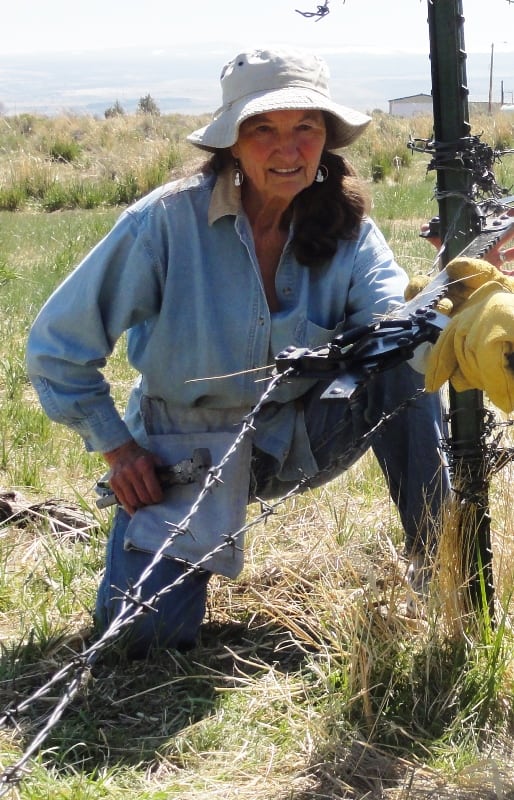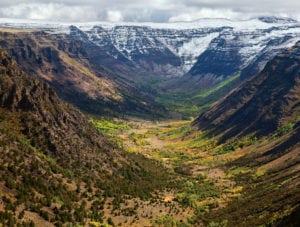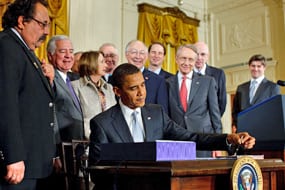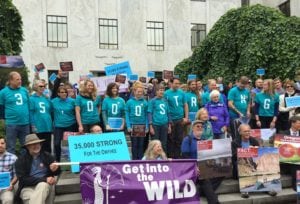For three decades, ONDA has been a strong, consistent voice for Oregon’s high desert. It all began in 1987 with extraordinary people concerned about an extraordinary place, and today has blossomed into the only organization that works exclusively on behalf of eastern Oregon’s high desert public lands and waterways.
 It’s been more than three decades since a Bend resident took out a newspaper ad and spread the word among like-minded friends: Come by Thursday night if you’re interested in protecting Oregon’s high desert.
It’s been more than three decades since a Bend resident took out a newspaper ad and spread the word among like-minded friends: Come by Thursday night if you’re interested in protecting Oregon’s high desert.
At that time, few were paying attention to the more than 13-million-acres of public land on the state’s dry side, says that resident, Alice Elshoff. By order of Congress, Bureau of Land Management staff were assessing public land in order to report on which swaths still retained the character of wilderness. But concerns abounded that critical areas were being left out.
“We felt the desert needed a voice,” Alice says.
About a dozen people showed up for that first meeting in 1987. At the next get-together, the small band decided on a name for a new group – the Oregon Natural Desert Association. They all kicked in $5 to get started.
Fast-forward 30 years and the fledgling nonprofit organization, also known as ONDA, has grown to encompass 10,000 members and supporters. It remains the only organization that focuses exclusively on Oregon’s high desert public lands.
The efforts of ONDA’s dedicated desert lovers have led to significant strides for conservation in eastern Oregon, from the designation of the state’s first three desert wilderness areas to the removal of roughly 2,400 tons worth of obsolete barbed wire fence at Hart Mountain National Antelope Refuge, allowing wildlife to move freely.
“It just shows that there was a need,” Alice says. “It was time we started thinking about Oregon’s high desert, and people have responded.”
Pioneering conservation in the high desert
 ONDA’s early days were of a small, scrappy group that still managed to have an impact. The organization hired its first employee five years after its start – Bill Marlett served as executive director until 2007, when Brent Fenty assumed the role.
ONDA’s early days were of a small, scrappy group that still managed to have an impact. The organization hired its first employee five years after its start – Bill Marlett served as executive director until 2007, when Brent Fenty assumed the role.
“No other group in Oregon was focused on desert wilderness and related issues,” Bill says, noting he’s proud that ONDA has “grown and persisted over time, becoming a force in the landscape of eastern Oregon.”
From water quality concerns to public lands protection, ONDA raised critical issues about our public lands in the 1990s. Legal advocacy led to the removal of livestock from the Donner und Blitzen and Owyhee Wild & Scenic River corridors, as well as to improved salmon and steelhead habitat on the John Day River.
And ONDA’s continued education around the value of the high desert — in a state that had long placed its identity in the forests and on the coast — became a hallmark of the organization, says John Sterling. John is a longtime ONDA board member and executive director of The Conservation Alliance, which works with outdoor recreation businesses on conservation efforts.
For instance, ONDA played a lead role in rallying support for permanent protection of Steens Mountain. Until its designation as wilderness in 2000, there was not a single acre of wilderness in Oregon’s high desert among the more than 2 million acres of wilderness existing statewide.
“ONDA is recognized as a leader among grassroots conservation organizations on public lands,” John says. “Other people pay attention to the work ONDA does.”
Foresight for Oregon’s dry side
 By the early 2000s, it had been roughly 20 years since land management agencies had assessed public lands in Oregon’s high desert for their wilderness quality. So ONDA decided to inventory the region to craft an up-to-date, on-the-ground assessment.
By the early 2000s, it had been roughly 20 years since land management agencies had assessed public lands in Oregon’s high desert for their wilderness quality. So ONDA decided to inventory the region to craft an up-to-date, on-the-ground assessment.
That data-driven approach helped draw Helen Harbin – now a longtime board member – to ONDA around that time. She recalls using gear and methodology that was at the forefront for its time on survey trips into the desert: clock the precise locale with a GPS unit, snap a picture with a camera, record the information into a three-ring binder.
She also liked how ONDA’s staff took calculated risks and approached issues creatively to get the work done. She recalls how, in working toward getting the Oregon Badlands Wilderness designated in 2009, ONDA built broad support with local businesses, neighboring property owners and others.
“I felt like if I gave them $20, they might squeeze $23 out of it,” she says.
Although volunteers now use iPads for survey tasks and the staff has grown to 16, Helen says the feel of ONDA has remained similar even as the approach to high desert conservation has become more sophisticated.
“I feel like that leanness and fiscal conservativeness is still there,” Helen says. “And we still strategically push the envelope.”
Pushing the envelope has meant posing solutions. When ONDA objected in 2009 to an industrial wind turbine proposal in critical wildlife habitat at Steens Mountain as “right approach, wrong place,” the organization also pulled together a report that pinpoints sites in eastern Oregon for such development that would be less impactful on landscapes and wildlife.
And initiatives like the 750-mile Oregon Desert Trail have introduced the state’s high desert to others, expanding knowledge and appreciation of the need to preserve the best of this spectacular region.
A growing community
 Today, 30 years since the beginning, the presence of ONDA’s members and supporters is felt across the state. Hundreds of volunteers each year contribute thousands of hours toward improving the health of public lands throughout eastern Oregon. Passionate supporters through thousands of calls, letters and emails sent to our leaders have urged for permanent protection of the Owyhee Canyonlands, making it a state and national conservation priority.
Today, 30 years since the beginning, the presence of ONDA’s members and supporters is felt across the state. Hundreds of volunteers each year contribute thousands of hours toward improving the health of public lands throughout eastern Oregon. Passionate supporters through thousands of calls, letters and emails sent to our leaders have urged for permanent protection of the Owyhee Canyonlands, making it a state and national conservation priority.
For all that has been achieved, ONDA still has a lot of work left to accomplish its vision. Nearly 3 million acres of Wilderness Study Areas in the high desert lack permanent protection, and national politics have put the very notion of public lands in jeopardy. ONDA is working to bring people together to keep public lands in public hands, and there remains optimism that places like Sutton Mountain and the Owyhee Canyonlands will finally get the protection they deserve.
Wilderness legislation to protect Sutton Mountain was introduced by Senator Jeff Merkley in 2015, and a mineral withdrawal bill for the Owyhee was introduced by both senators last year.
“I’m extremely proud that ONDA has brought such broad support and diverse voices together on behalf of places like Sutton Mountain,” says Brent Fenty, ONDA’s executive director. “These efforts are a perfect illustration that common ground can be found in the future of public lands management. These successes don’t come easy but leaving these places intact for future generations is worth the effort.”
The continuously growing community that is ONDA is ever-more critical today, John Sterling says.
“Every generation or so, we have to renew our commitment to public lands,” he says. “And we are at that juncture right now. Part of that is connecting to organizations like ONDA – which continues to be a strong voice for a place we all love.”
– Heidi Hagemeier